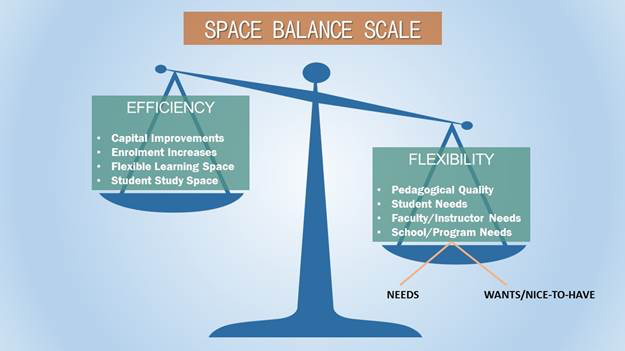
Funding for higher education ebbs and flows based on government support and tuition revenue. When the dollars flow, we have the tendency to spread our wings. New capital infrastructure adds valuable square feet that are filled quickly, whether they are needed or not. These periods of space affluence are generally short but they favor a high degree of space and timetabling flexibility for faculty. In some cases, this flexibility lends value to teaching and learning but in many others, it is simply a case of hoarding, serving wants more than needs.
So, what is space flexibility? Space flexibility is more than just adding square feet to a school’s footprint. Flexibility can include scheduling two spaces at once to be able to move fluidly between two types of lessons (such as lab and lecture). It can include a space that is designed for both classroom lecture and student project work. It can also involve flexibility in faculty schedules, such as not teaching before 10:30 am or not teaching on Friday afternoons. Any behavior that contributes to lower room or seat utilization rate can be attributed to space flexibility.
Space flexibility can provide value but it comes at a cost that few institutions understand. As capital funding is scaled back and enrollment or research continues to grow, space becomes a scarce and valuable commodity. I’ve always reminded people that “It’s not a problem until it’s a problem, then it’s a problem.” Institutions without rules around space stewardship have a very difficult time changing space-related behavior. The cost of flexibility can impact the institution’s ability to develop its capital infrastructure during periods of fiscal restraint and it historically stunts innovation and modernization.

(Figure 1. Balancing efficiency with flexibility.)
How do you bring these two into balance? By applying flexibility controls.
Changing space behavior in higher education is a challenging change management project. The existing culture of space ownership and current attitudes toward flexibility are not easy to change. BCIT, a polytechnic college with 2.3 million square feet spread across 61 buildings, was under pressure to accommodate significant enrolment increase with little likelihood of new capital infrastructure. In January 2014, I was hired by the institution to begin solving the space challenge.
Initial insights into valid utilization data made the problem very clear. There was a subset of space behavior that was as diverse as our programs and it was preventing access to rooms that were sitting empty. If the challenge is cultural, then the solution is to change the culture. At every stakeholder meeting, I bring with me the following diagram. It articulates very clearly why we are space challenged (flexibility) and how programs will benefit if we are more efficient with space use. Ultimately, the lower our square foot per FTE, the greater the ratio of tuition revenue to operating costs.
Bringing these two into balance requires cultural change. Imagine I came into your house and announced that because I didn’t feel you were using your guest bedroom effectively, I would be sending my teenage son to live with you from now on. Or maybe you go skiing every Saturday in the winter, so as long as your house is empty on that day, my family, dog included, will be visiting. These scenarios make people uncomfortable. In order to bring balance to the space equation you must clearly articulate how the stakeholders will benefit if they compromise on flexibility:
- Are they interested in teaching in flexible learning spaces? Do students need informal learning spaces? Do they need to modernize learning technology? Sometimes, a simple furniture refresh is enough to entice faculty to change behavior and relinquish space. Functional space improvements are the short-term carrot that typically draws out compromise.
- Another carrot can be the opportunity to increase enrollment, improve program tuition revenue and climb the prioritization ladder. In a space constrained environment, I always ask schools to look first within their own footprint to find efficiencies with space and scheduling. In many cases where we perform utilization analysis, it is the first time faculty have seen data that reflects their academic activity. The sobering numbers often make the solution to space challenges very obvious.
Two years ago, I ran a utilization analysis on a room that was dedicated to an engineering program. This room was unique because it had a floating floor, deep classroom tables with integrated power and data, and smart classroom technology, making it perfect for Bring-Your-Own-Device deployment. Utilization data told me that the room was chronically under-utilized. Seat utilization hovered around 66%, daytime room utilization was 55% and evening/weekend utilization was 0%. This room was very valuable to continuing studies and also to other programs who were looking for space attributes that already existed in this room. And at 55% room utilization, the room was empty for 17 daytime hours per week.
On a visit to the room, I found 3 bar fridges, 2 microwaves and a panini grill had been installed by students who used the empty room as a hangout spot and as a space to collaborate on projects. Upon hearing that I had visited the room, the program head contacted me to convey that the dedicated use of this room was critical to the success of his students.
I disagreed and called a stakeholders meeting to investigate the space challenges. I presented the utilization analysis to establish room use patterns. Once it was clear how the engineering program was using the room, I presented the Space Balance Scale graphic (see Figure 1, above). This scale went a long way to defining the value to the program of relinquishing some of the flexibility they had with a very valuable room.
We then looked at some of the value they might see if they forfeited the room during hours when it was not scheduled for academic activity. This included new student project rooms in the adjacent hallway, which would allow students to collaborate on projects in purpose-built space rather than in a BYOD classroom. Our Student Association already provides microwaves for students in common areas for students to prepare food, but the panini grill simply had to go.
A few other concessions were made with the program and they agreed to have priority scheduling for this room but to make the room available for general timetabling when they didn’t need it. This opened 17 new hours of availability Monday to Friday daytime and 28 hours of activity across the evenings and weekends. Feedback from students indicated that they preferred working in the project rooms rather than squatting in their classroom, but they still miss the panini grill.
Where there is compromise in space flexibility there should always be an investment in space infrastructure. Balancing off flexibility with efficiency is critical to ensuring you are providing the best learning spaces for your students, even during times of space affluence. Understanding that balance and selling to leadership, faculty and admin is a key component to effectively changing space culture and your institution.

